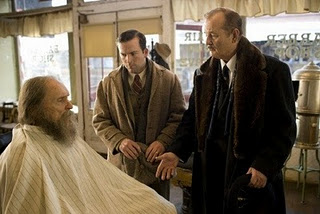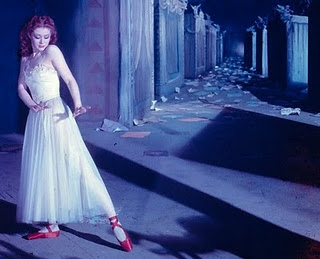by Raj Ranade
Get Low opens at the Kentucky on Friday, 8/27. The Red Shoes plays as part of the Summer Classic Film Series at the Kentucky Wednesday, 9/1.

Universal Law of Cinema #436 states that the most satisfying part of any film including in its cast the actor Bill Murray will be the actor Bill Murray. In this regard, the debut film from director Aaron Schneider, Get Low (trailer), does not disappoint (Universal Law of Cinema #437 states, on the other hand, that serious films shall endeavor to avoid any titular resemblance to noted singles by Lil Jon & the East Side Boyz, but I digress). Low tells the story of a hermit who decides to throw his own funeral party, and Murray plays the funeral parlor owner who decides to oblige him, against most state, federal, and theological regulations.
Murray’s character Frank Quinn is not someone you would call of a man of virtue – “That’s the thing about Chicago,” he says wistfully as he laments the dearth of funeral business in his Depression-era Tennessee town, “people know how to die.” But he is still a man of fundamental principle, continually tempted by sin, by the bags of others’ money that soon end up on his desk, but only ever leaning slightly in its direction. It’s a remarkable performance, one that resounds with complexity.
Shame about the rest of the movie. It’s not that Get Low doesn’t have its pleasures. Actors like the great Robert Duvall and Sissy Spacek are never exactly bad, and Duvall in particular combines his trademark ability for layering repressed emotions underneath an enigmatic veneer with a winning cantankerousness that plays well against Murray’s embodiment of deadpan. And Schneider, a former cinematographer, can certainly shoot the hell out of the backwoods of Tennessee, casting his detailed period piece environments in a sepia glow that occasionally bursts into fiery color.
But when the movie transitions from genial comic fable to serious drama, it more or less collapses. Duvall’s hermit, you see, went into his 40-year isolation because of the Dark Secret in his Past™, a sin that left him inconsolable for years and that now finally has him seeking redemption. Schneider builds his movie around the suspenseful reveal of this secret at the end, which is a dangerous game to play, since anything short of a Crying Game-level corker will inevitably end up disappointing the audience.
But on a scale from late-period Shyamalan to early-period Shyamalan, the payoff here lands at the same level as “It was all a dream” (non-Inception division). Without spoiling anything, I’ll say that the sin that is the story’s linchpin is “bad,” but it’s the kind of “bad” that can be very easily forgiven by audiences – and a redemption story without something truly worthy of redemption is nothing more than a tease.
The stock answer on how to improve this ending is to never reveal the big secret at all, but that’s a cliche itself in this day and age. No, a braver movie would have challenged its audience, assigning a genuinely transgressive act (for our age, not theirs) to the tormented hermit. As it stands, the ending is a fundamental cop-out, one that can make the rest of the movie seem like a con game.
All that said, of course, having lowered expectations for the ending will no doubt allow you to appreciate the ride there much more (you’re welcome). And if you think watching two of the greatest American actors riffing with each other is worth the price of admission, Get Low is certainly a pleasant enough time at the movies. Just be wary of false prophets promising screen redemption* – true movie salvation requires a little more than jokes and beautifully photographed candlelight.
GQ’s recent interview with Bill Murray includes his behind-the-scenes thoughts on Get Low.
*Which reminds me – Duvall’s greatest screen performance is likely his turn as a sinning Pentecostal preacher in The Apostle (trailer), a masterpiece which he both wrote and directed.
Wednesday Hollywood Movie Classics at the Kentucky Theatre: The Red Shoes

It may surprise you to learn that the favorite film of Martin Scorsese is The Red Shoes (trailer), the 1948 movie about ballet from directors Michael Powell and Emeric Pressburger that plays at The Kentucky Theatre on Wednesday (9/1). The type of red that Scorsese is usually concerned with, after all, has less to do with footwear than with arterial sprays. But the first clue is a brief exchange between ballerina protagonist Vicky Page (Moira Shearer) and the composer she will soon fall in love with (Anton Walbrook). “Why do you want to dance?” he asks. “Why do you want to live?” she replies.
The Red Shoes soon gives Vicky the Hollywood arc of a rising star and entangles her in a love triangle with the composer and a brooding ballet troupe impresario, but it’s those questions that are the true focus of the film. Along with Vertigo and (yes) Raging Bull, The Red Shoes is one of the great cinematic stories of self-destructive obsession, the kind that makes one’s passion and one’s life mutually exclusive. And it expresses those whirlpool of emotions through operatic filmic textures that were revolutionary for the time and remain utterly awe-inspiring today.
The central example is the 17-minute dance sequence at the film’s midpoint. Up to this point, filming dance mainly involved keeping a still camera on a talented dancer for as long as possible. But Powell and Pressburger sought to replicate the expressiveness of dance and music in cinematic language.
For every crescendo and glissando, every spin and twirl, the directors created a dazzling corollary – the film gently glides behind the dancers in elegant tracking shots, pirouettes with flurries of quick edits, and leaps into arrays of psychedelic imagery that bend the laws of reality. The scene, perhaps the great dance sequence of the cinema, is stunning enough that it transcends the form of ballet and becomes a pure multi-sensory artistic expression of emotion, one that will stun viewers with simplistic preconceived notions about how ballet is always boring (read: me).
Powell’s film was a passionate plea to a jaded post-WWII generation. “For 10 years we had all been told to go out and die for freedom and democracy,” he said, “but now that the war was over, The Red Shoes told us to go out and die for art.” The message still resonates today, and the fact that Lexington audiences have the chance to see this ground-breaking movie in the otherworldly vividness of authentic Technicolor film is truly special. Indeed, the real question that the film raises after a viewing isn’t why Scorsese, who supervised the film’s meticulous restoration, continually champions it – it’s why more other directors don’t.







